Intel's Bean Canyon (NUC8i7BEH) Coffee Lake NUC Review - Ticking the Right Boxes
by Ganesh T S on April 3, 2019 8:00 AM EST- Posted in
- Systems
- Intel
- NUC
- UCFF
- Thunderbolt 3
- Cannon Point
- Coffee Lake-U
GPU Performance - Gaming Workloads
Our gaming test suite (revamped last year) involves six different games:
- Civlization VI (DX12)
- Dota 2
- F1 2017
- Grand Theft Auto V
- Middle Earth: Shadow of War
- Far Cry 5
Most system reviews take a handful of games and process them at one resolution / quality settings for comparison purposes. Recently, we have seen many pre-built systems coming out with varying gaming capabilities. Hence, it has become imperative to give consumers an idea of how a given system performs over a range of resolutions and quality settings for each game. With our latest suite, we are able to address this aspect.
Civilization VI (DX12)
The Civilization series of turn-based strategy games is very popular. For such games, the frame rate is not necessarily an important factor in the gaming experience. However, with Civilization VI, Firaxis has cranked up the visual fidelity to make the game more attractive. As a result, the game can be taxing on the GPU as well as the CPU, particularly in the DirectX 12 mode.
| Civilization VI (DirectX 12) Performance | |||
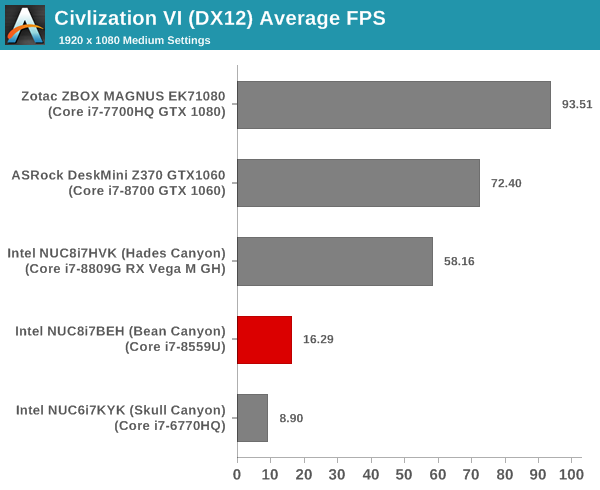
We processed the built-in benchmark at two different resolutions (1080p and 2160p), and with two different quality settings (medium and ultra, with the exact differences detailed here). It is no surprise that the discrete GPU-equipped systems are much further ahead.
Dota 2
Dota 2 has been featuring in our mini-PC and notebook reviews for a few years now, but, it still continues to be a very relevant game. Our evaluation was limited to a custom replay file at 1080p resolution with enthusiast settings ('best-looking' preset). We have now revamped our testing to include multiple resolutions - This brings out the fact that the game is CPU-limited in many configurations.
Dota 2 allows for multiple renderers - we use the DirectX 11 mode. The rendering settings are set to 'enthusiast level' (best-looking, which has all options turned on, and at Ultra level, except for the Shadow Quality set to 'High'). We cycle through different resolutions after setting the monitor resolution to match the desired resolution. The core scripts and replay files are sourced from Jonathan Liebig's original Dota 2 benchmarking instructions which used a sequence of frames from Match 3061101068.
| Dota 2 - Enthusiast Quality Performance | |||
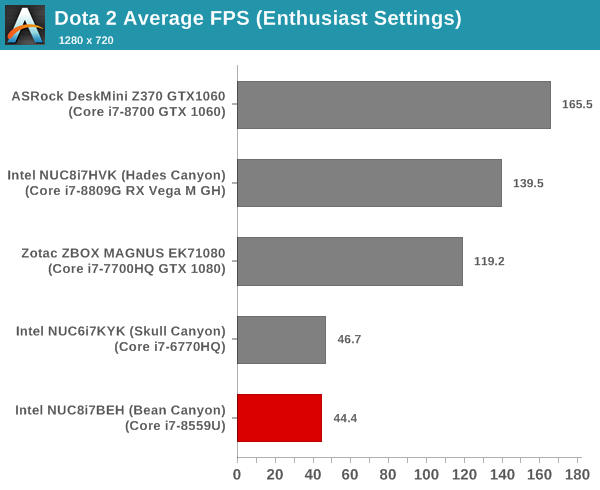
F1 2017
Our gaming system reviews have always had a representative racing game in it. While our previous benchmark suite for PCs featured Dirt 2, we have moved on to the more recent F1 2017 from Codemasters for our revamp.
| F1 2017 - Ultra Quality Performance | |||
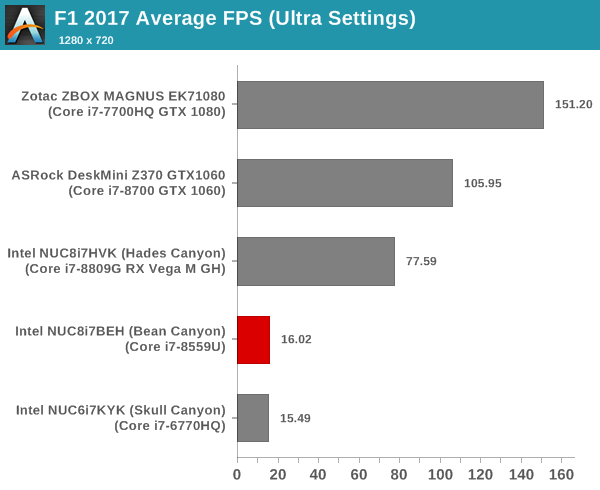
The supplied example benchmark (with some minor tweaks) is processed at four different resolutions while maintaining the graphics settings at the built-in 'Ultra' level. We see the same scenario of the dGPU systems marching well ahead of the Bean Canyon NUC.
Grand Theft Auto V
GTA doesn’t provide graphical presets, but opens up the options to users and extends the boundaries by pushing even the hardest systems to the limit using Rockstar’s Advanced Game Engine under DirectX 11. Whether the user is flying high in the mountains with long draw distances or dealing with assorted trash in the city, when cranked up to maximum it creates stunning visuals but hard work for both the CPU and the GPU. For our test we have scripted a version of the in-game benchmark. The in-game benchmark consists of five scenarios: four short panning shots with varying lighting and weather effects, and a fifth action sequence that lasts around 90 seconds. We use only the final part of the benchmark, which combines a flight scene in a jet followed by an inner city drive-by through several intersections followed by ramming a tanker that explodes, causing other cars to explode as well. This is a mix of distance rendering followed by a detailed near-rendering action sequence.
| Grand Theft Auto V Performance | |||
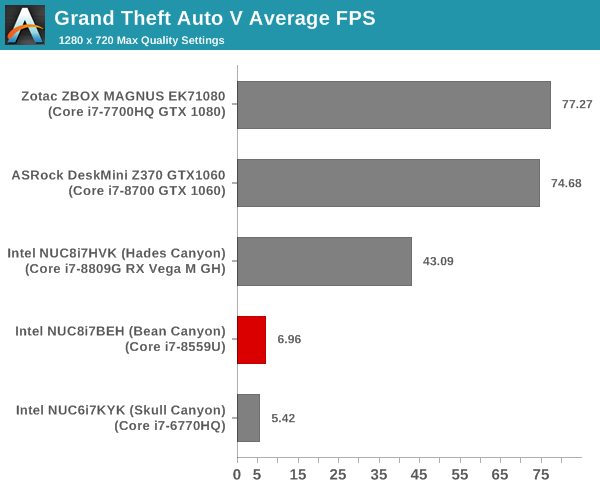
We processed the benchmark across various resolutions and quality settings (detailed here). The results are presented above.
Middle Earth: Shadow of War
Middle Earth: Shadow of War is an action RPG. In our previous gaming benchmarks suite, we used its prequel - Shadow of Mordor. Produced by Monolith and using the new LithTech Firebird engine and numerous detail add-ons, Shadow of War goes for detail and complexity. The graphics settings include standard options such as Graphical Quality, Lighting, Mesh, Motion Blur, Shadow Quality, Textures, Vegetation Range, Depth of Field, Transparency and Tessellation. There are standard presets as well. The game also includes a 'Dynamic Resolution' option that automatically alters graphics quality to hit a pre-set frame rate. We benchmarked the game at four different resolutions - 4K, 1440p, 1080p, and 720p. Two standard presets - Ultra and Medium - were used at each resolution after turning off the dynamic resolution option.
| Middle Earth: Shadow of War Performance | |||
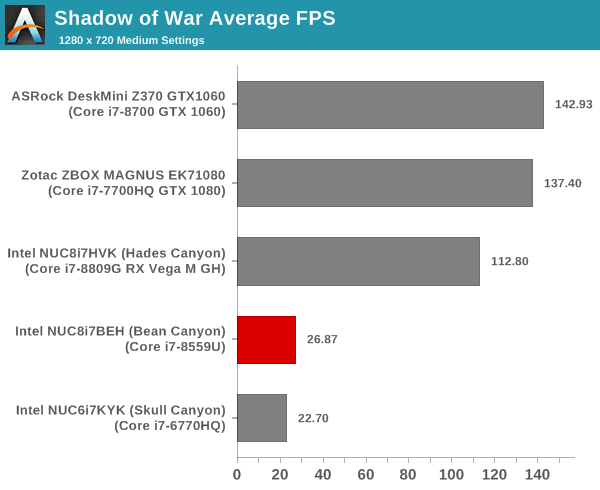
Far Cry 5
Ubisoft's Far Cry 5 is an action-adventure first-person shooter game released in March 2018. The game comes with an in-built benchmark and has standard pre-sets for quality settings. We benchmarked the game at four different resolutions - 720p, 1080p, 1440p, and 2160p. Two preset quality settings were processed at each resolution - normal and ultra.
| Far Cry 5 Performance | |||
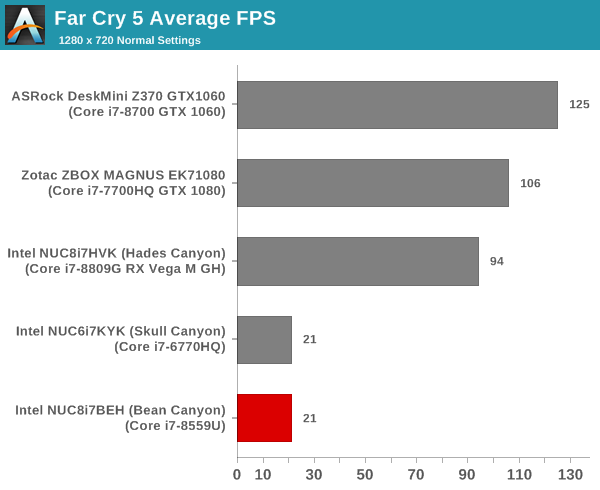
Overall, the Iris Plus Graphics 655 in the Core i7-8559U is a decent upgrade over the Iris Pro Graphics 580 in the Core i7-6770HQ. However, discete GPUs are a must for playable frame rates in any of the games considered above.










81 Comments
View All Comments
cacnoff - Wednesday, April 3, 2019 - link
These are platform PCIe lanes that come off the OPI (on package interface) as there are no discrete pch options for U series cpus.Check the direct processor page here.
https://www.intel.com/content/www/us/en/products/p...
"PCI Express (PCIe) Configurations describe the available PCIe lane configurations that can be used to link the PCH PCIe lanes to PCIe devices."
DenvR - Wednesday, April 3, 2019 - link
I'm pretty sure all 14nm U-series processors feature at least 8 PCIe 3.0 lanes, some even more (the i5-7200U has got 12 of those and the i7-8559U 16. Please correct me if I'm wrong.vortexmak - Wednesday, April 3, 2019 - link
Did Intel drop the IR receiver from the NUC?mikato - Thursday, April 4, 2019 - link
I wondered this also. The board layout diagram has a "CIR Receiver" so maybe that's it. But I'm really surprised there is no mention in the system specs table next to I/O or in any of the HTPC pages of the article. Wasn't it one of the good selling points of these Intel boxes?CSMR - Wednesday, April 3, 2019 - link
Shame that this is lacking a full displayport output, instead making it an old DP1.2 share a thunderbolt output. Displayport is more important than hdmi for a machine that is overkill for HTPC use. i7s will be much more often connected to monitors than to TVs.mischlep - Wednesday, April 3, 2019 - link
For the Intel NUC8i7BEH (Bean Canyon), in the Comparative PC Configurations, does the listed price "$963 (as configured)" include an OS or not? The other selections (other than the NUC7i7BNH) explicitly said "as configured, No OS". You specifically marked it as "as configured, no OS" in the specifications on the first page.PeachNCream - Wednesday, April 3, 2019 - link
The price is a bit high, but I'm guessing some of that is due to the Iris GPU which is a thing I'd love to see appear in a wider variety of systems. Iris is a good idea from a power consumption and cooling simplification standpoint when compared to most dGPU offerings on the lower end of the scale.QChronoD - Wednesday, April 3, 2019 - link
Still only HDMI 2.0 and DP1.2 on these? I guess I can only hope that next version will have finally been updated to support 4k120 w/ VRR.abufrejoval - Wednesday, April 3, 2019 - link
This CPU IMHO is one of the best designs Intel has and I’ve been itching to buy one of these for quite some time, albeit always in a slightly different form factor.For starters just enter i7-8559U into your Google search bar and hit “shopping”. You’ll notice, there are exactly two offerings: The NUC for around €500 and the MacBooks between €2000 and €3500. Perhaps the latter costs extra, because it includes one Terabyte of SSD, €120 these days in a market with competition. It certainly has just the same CPU/GPU as the €2000 model.
I own the Skylake predecessor, also designed for Apple, an i5-6267U but in a cheap Windows notebook, which has an Iris 550 iGPU with close to identical graphics performance, but only half the number of cores that top out at 3.3 GHz, but doesn’t drop below 2.9 GHz even if abused by Prime95.
It’s a sweet machine, giving nicely balanced CPU and graphics power and most importantly, it had zero price premium at the time, for twice the graphics punch of ordinary 520 or 530 iGPUs. It also performs very much identical to a 512 graphics core Kaveri A10-7850K in *every regard*, CPU INT and FP, GPU, OpenCL, only that the Kaveri uses 95 Watts not 28. It was quite simply the better APU and stopped me buying AMDs since.
It also has such great Linux compatibility CentOS, Fedora, Ubuntu and Android-x86, none of the grief Nvidia and AMD give you: I know how to manage that with all those V100, GTX and RTX I operate, but I also appreciate not having to.
Alas, you cannot buy this newer CPU inside a notebook other than at crazy Apple prices. And incidentally, you cannot buy it as a Mini-ITX either: You’re stuck with NUC or nothing… which is sort of ok, now that you stuff terabytes of NVMe at affordable prices inside.
This chip must be quite a bit more expensive to make, twice the GPU silicon real-estate, eDRAM, packaging etc., but Intel doesn’t charge extra for GPU, no matter what type, just for peak clock speed.
But it seems they also simply won’t sell the chip, not for the official price or any other, unless you’re Apple or buy a NUC. I still don’t know how Medion managed to grab sufficient number of them to produce a €600 laptop, but I knew enough to grab one, enjoyed it ever since and I am writing on it just now.
So if I cannot have another as a notebook, I’d love to use it as a mini-server: That’s another use case where the fantastic power efficiency at low loads or idle, combined with its pretty awesome sprint power is well appreciated. But I’d really like it to have ECC memory then and a slightly bigger fan for quiet operation even under load, because it will run “forever” and use consistency critical stuff, including ZFS for Linux.
But because that makes it the nicer Xeon-D for many, Intel will cut that fuse…
For Intel this NUC must be one of the lowest profit items in their inventory, which translates to one of the best value propositions if you can live with the limitations. In theory you should be able to buy the board without the case and there is at least one company out there that sells fan-less cases to fit the guts of this NUC.
Even if that case costs a €200 premium, you can still buy two fully loaded passive NUCs with 32GB of RAM and 4TB of SSD before you reach Apple entry territory.
gglaw - Wednesday, April 3, 2019 - link
"With Thunderbolt 3 having matured, and the availability of various eGFX enclosures, the absence of a discrete GPU in the NUC8i7BEH will hardly be felt."completely disagree. Relying on huge, bulky, and costly external implementations is a horrible idea compared to paying a small premium and getting better GPU inside the NUC. Who in the world would buy a mini PC knowing they're going to frequently need to plug it into a huge box multiple times the size of the NUC and driving the total cost to a whole new bracket? There's a reason why the eGFX market is a tiny, niche market.
These are not priced as budget PC solutions, so the small price bump to get better graphics inside the box is completely worth it for users who want that type of performance. Or for others who will use it strictly for media and productivity the can stick with Intel Graphics. Almost no one should buy the base Intel Graphics with the idea of adding an eGFX solution later. They'd be better off selling the base one and buying a Ryzen or Vega M-Intel solution.